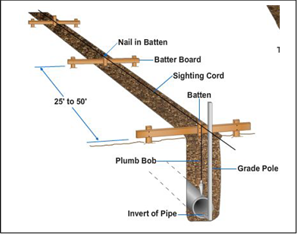| 1. |
Construction surveys include reconnaissance, preliminary, location, and layout surveys.
Which one of the followings is needed to accomplish that plan?
- Gathering reconnaissance information and preliminary data engineers require for selecting suitable routes and sites and for preparing structural designs.
- Defining selected locations by establishing a system of reference points.
- Guiding construction forces by setting stakes or otherwise marking lines, grades, and principal points and by giving technical assistance.
- Measuring construction items in place for the purpose of preparing progress Reports.
- Dimensioning structures for preparation of as-built plans
|
|
|
1,2 and 4 |
|
|
Only 3, and 5 |
|
|
1,2,3,4, and 5 |
| 2. |
A Bench Mark (BM) is a relatively permanent object, natural or artificial, bearing a marked point whose elevation is known. BMs are established over an area to serve as what? |
|
|
starting points for leveling operations so the topographic parties can determine other unknown elevation points and |
|
|
Reference marks during later construction work. |
|
|
Both above |
| 3. |
Figure 1 shows: |
|
|
Brass shaft stocks in the tops of permanent horizontal control points, also known as monuments. |
|
|
Markers for foundation, utility and plumbing in the field. |
|
|
Two concrete blocks and an Iron pipe |
| 4. |
Tidal datums are specific tide levels that surveyors use as surfaces of reference for: |
|
|
depth measurements in the sea and as a base for determining elevations on land. |
|
|
Mean sea level |
| 5. |
Drainage is the construction of facilities needed to allow excess surface and subsurface water to flow from the construction site. Properly designed and constructed drainage systems are one of the most important parts of a construction project. Without proper drainage, rainwater and water running off the surrounding ground could turn the area into a lake. It is also necessary to drain off surface water that would soak down and wet the subgrade. |
|
|
True |
|
|
False |
| 6. |
Which one of the following is needed to have a finished drainage system? |
|
|
Ground slope |
|
|
Ditches |
|
|
Culverts |
|
|
Gutters |
|
|
Storm drains |
|
|
Underground water drains |
|
|
All of the above |
| 7. |
Before foundation and footing excavation for a building can begin, |
|
|
The building lines must be laid out to determine the boundaries of the excavations. |
|
|
The drainage system needs to be built. |
| 8. |
Batter boards are erected to:

|
|
|
Preserve the corner locations. |
|
|
Provide a reference measurement down to the prescribed elevations. |
|
|
Both above |
| 9. |
The picture below is a diagram of :

|
|
|
Use of the batter board for an underground utility stakeout. |
|
|
A French drainage system. |
| 10. |
The starting point of a survey is also called the starting station and is numbered 0 + 00. The next station is 100 feet farther away and is numbered 1 + 00. The next station, which is 200 feet beyond the starting point, is then numbered 2 + 00, and so forth. All stations that end with 00 are called full stations. |
|
|
True |
|
|
False |
| 11. |
Soils are divided into |
|
|
Two major divisions, coarse -grained soils, fine-grained soils. |
|
|
Three major divisions, coarse -grained soils, fine grained soils, and highly organic soils. |
| 12. |
Compaction is the process of increasing the density, or the amount of solids per unit volume, of soil by mechanical means to improve such soil properties as strength, permeability, and compressibility. Compaction is a standard procedure used in the construction of earth structures, such as embankments, subgrades, and bases for road and airfield pavement. |
|
|
True |
|
|
False |
| 13. |
The bearing capacity of a soil is expressed in terms of shear resistance, which means the capacity of the load-bearing portion of a material or member to resist displacement in the direction of the force exerted by the load. |
|
|
True |
|
|
False |
| 14. |
Which of the following is the purpose for soil stabilization? |
|
|
Strength improvement. |
|
|
Dust control. |
|
|
Soil water proofing. |
|
|
All above. |
| 15. |
Which one the following is a major control factor when working with soil-cement? |
|
|
The proper cement content is needed. A rule of thumb: use one 50-pound bag per square yard. |
|
|
Proper moisture content. A soil sample should make a firm cast when squeezed in your hand without squeezing out any water. |
|
|
Adequate compaction. The principles of compacting soil-cement are the same for compacting the same soils without cement treatment. Compact the soil-cement mixture at optimum moisture content to maximum density and finish it immediately. Moisture loss by evaporation during compaction, as indicated by the graying of the surface, should be replaced with light applications of water. |
|
|
All above |
|